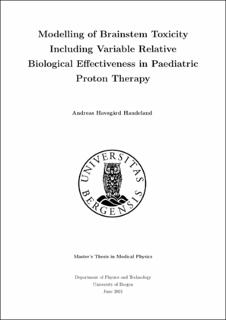| dc.contributor.author | Handeland, Andreas Havsgård | |
| dc.date.accessioned | 2021-06-17T00:00:59Z | |
| dc.date.available | 2021-06-17T00:00:59Z | |
| dc.date.issued | 2021-06-01 | |
| dc.date.submitted | 2021-06-16T22:00:20Z | |
| dc.identifier.uri | https://hdl.handle.net/11250/2759841 | |
| dc.description | Revised edition. Minor spelling errors corrected. | |
| dc.description.abstract | Brainstem necrosis is a rare but severe side-effect following paediatric proton therapy. Substructures of the brainstem may be associated with regional differences in radiosensitivity, but these are not accounted for clinically. The relative biological effectiveness (RBE), the ratio between a test dose and reference dose resulting in the same clinical endpoint, is also assumed to be constant for proton therapy. This may underestimate the biological effect of the radiation since the RBE is thought to be variable across the beam profile. Current dose constraints and normal tissue complication probability (NTCP) models for adult tissues are further developed than ones based on paediatric patients. However, paediatric tissue is associated with different radiosensitivity than adult tissues, and more data is required to quantify this. This study aimed to further explore the association between variable RBE, regional radiosensitivity of the brainstem and brainstem toxicity of paediatric proton therapy patients. A cohort of 36 paediatric proton therapy patients that received significant dose to the brainstem, and were subsequently at risk of brainstem necrosis, were included in a case-control study. The patients had RBE-weighted dose distributions and dose-averaged linear energy transfer (LETd) distributions recalculated with the FLUKA Monte Carlo code for variable RBE models. The brainstem was delineated into substructures. Dose-volume histograms and dose statistics of the cohort were used to fit Lyman-Kutcher-Burman(LKB) models to the data for different RBE-weighted dose distributions and substructures. Dose statistics were also used as a basis for cluster analyses to explore regional differences across the brainstem. The results showed higher average variable RBE-weighted dose and LETd observed for cases compared to controls, while this was not the trend for the constant RBE factor. This thesis shows the first fitting of LKB models to substructures of the brainstem. For the full brainstem structure, the tolerance dose (TD50) range was 61.7−68.6 Gy(RBE) using RBE1.1 and 65.4−70.0 Gy(RBE) based on the variable RBE models. The cluster analysis separated the data points into a small number of relatively solid clusters but overall did not show clear trends in sorting out cases from controls. | |
| dc.language.iso | eng | |
| dc.publisher | The University of Bergen | |
| dc.rights | Copyright the Author. All rights reserved | |
| dc.subject | Machine Learning | |
| dc.subject | NTCP Models | |
| dc.subject | NTCP | |
| dc.subject | Variable RBE | |
| dc.subject | Cluster Analysis | |
| dc.subject | Brainstem Necrosis | |
| dc.title | Modelling of Brainstem Toxicity Including Variable Relative Biological Effectiveness in Paediatric Proton Therapy | |
| dc.type | Master thesis | |
| dc.date.updated | 2021-06-16T22:00:20Z | |
| dc.rights.holder | Copyright the Author. All rights reserved | |
| dc.description.degree | Masteroppgave i fysikk | |
| dc.description.localcode | PHYS399 | |
| dc.description.localcode | MAMN-PHYS | |
| dc.subject.nus | 752199 | |
| fs.subjectcode | PHYS399 | |
| fs.unitcode | 12-24-0 | |
